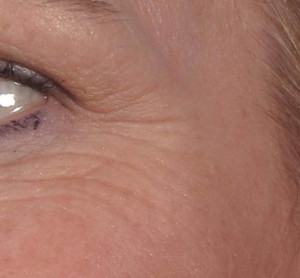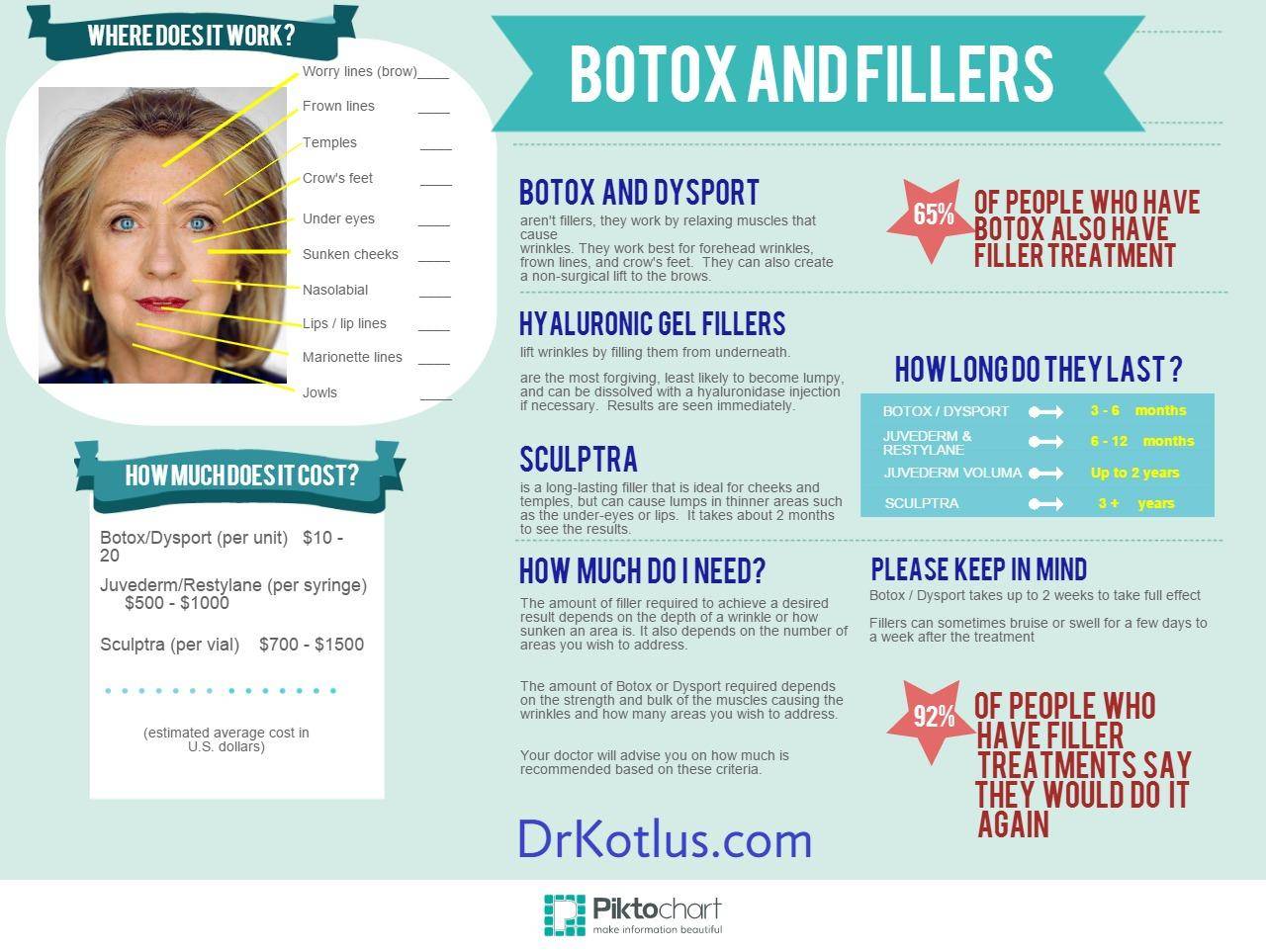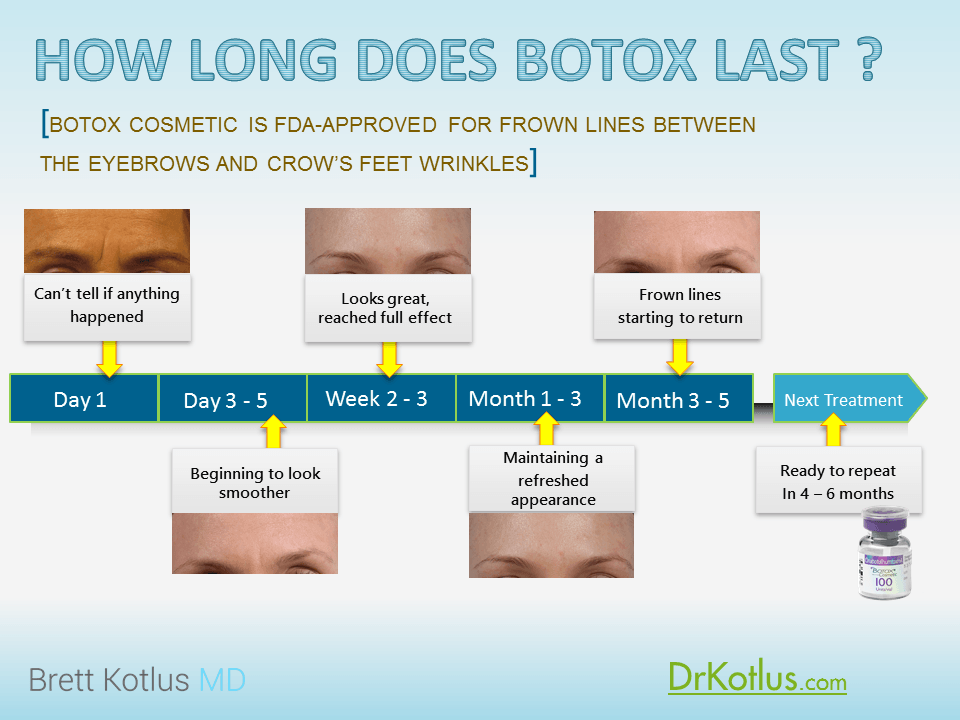Posts
Episode #8: Lower Blepharoplasty Variations and the Most Expensive Cocktail in the World
in Eye lift, Podcast/by drkotlus4 eye secrets to looking younger in photos (#1 and #2 won’t cost a dime)
in Eye lift, Look Better in Photos, News, Wrinkles/by drkotlusWhat is the difference between Botox and Fillers ?
in Botox and fillers, Infographics, Wrinkles/by drkotlusBotox or fillers ?
“Do I need Botox and fillers?”
I’m asked this question almost every day in any of my New York offices (not to imply that wrinkles only happen to New Yorkers, it’s just where I practice).
The answer depends on where you have wrinkles or loss of fullness.
Sometimes the answer is both Botox and filler
Botox works best around the eyes- the frown lines between the eyebrows, the crow’s feet, and the forehead. Botox (and Dysport) relax the muscles that cause these expression lines.
In the hands of a Botox expert, Botox can gently lift the eyebrows, improve lines around the mouth, and lift the corners of the mouth.
Fillers are best for deeper creases, nasolabial creases (from the side of the nose to the mouth), lines that are not from expressions, and sunken areas (under eyes, cheeks, lips, temples).
“Will I have to do it again?”
Yes, if you want to keep looking younger . This infographic I made describes some of the differences and applications of Botox and fillers including the very popular Juvederm Voluma, Sculptra, and Restylane. Most of my patients who enjoy the benefits of injectable treatments undergo Botox approximately 3 times per year and fillers once or twice a year.
How to get rid of crow’s feet
in Botox and fillers, Wrinkles/by drkotlusCrow’s feet arise from repeated expression
“Crow’s feet” are the creases that radiate outward from the outer corners of your eyes when you smile or squint. They begin to show up for most people in the mid 30’s to early 40’s. They are thought to convey sincerity when you smile (see this video about the SQUINCH by photographer Peter Hurley). The crow’s lines can make you look more photogenic, but if you have too many or they are too deep, they make you look older.

“Crow’s Feet”
How do I get rid of them?
STEP 1 – PREVENTION
Use a broad-spectrum sunscreen of at least SPF 30 and preferably a mechanical blocking agent like zinc oxide. Even while you are driving, your face is exposed to damaging UV radiation that causes aging signs and wrinkles. Other ways to prevent these lines from forming or worsening, use scientifically-proven topical creams like a prescription-strength retinol and a vitamin C (L-ascorbic acid). I don’t recommend that you stop smiling in order to prevent smile lines. You may look younger, but you will lead a less happy life!
STEP 2 – TARGETED MUSCLE RELAXATION
Botulinum toxin type A (Botox, Dysport, Xeomin) are liquid protein injections that selectively relax the muscles that create the crow’s lines. An expert injector can do wonders by placing small amounts of Botox in just the right places. Botox done well looks natural and gives your eyes a younger glow.
STEP 3 – SKIN RESURFACING
Lasers (fractional CO2 and erbium) and chemical peels (glycolic, TCA, phenol) will remove the outer skin layers leaving space for newer, smoother skin to take over. In the case of crow’s feet, if you continue to crease with repeated expressions, the lines will eventually return. A combination of resurfacing with Botox as maintenance will provide the longest-lasting results.
What about fillers like Juvederm or Restylane?
Fillers have a limited role in treating crow’s lines but can be helpful in smoothing very deep, fixed creases. Dermal fillers can also stiffen and plump the skin to limit the amount of folding and creasing that occurs when you squint.
What about eye lift surgery?
A lower or upper eyelid lift may somewhat reduce crow’s feet but is not a good choice if your primary target is expression lines. Surgery is better for heavy upper eyelid skin or lower eyelid bags.
How long does Botox last?
in Botox and fillers, Infographics/by drkotlusBotox starts to work after a few days and lasts for months.
How many months is the big question. I’ve been treating patients with cosmetic botulinum type A since my residency days in New York City and I’ve administered thousands of Botox injections. On average, Botox lasts about 4 months. But, this isn’t the case for everyone. Why?
Botox works better with successive treatments.
The smoothing effect on wrinkles is a result of targeted muscle relaxation. When a muscle isn’t moving as much as it used to, it begins to shrink. Just like when you remove a cast from your arm that has been there for 2 months, the arm looks smaller. With the next Botox treatment, your muscle may take longer to recover because it’s smaller. I have some patients that see Botox results for 6 – 9 months, mostly if they have been getting treatments for a few years.
What if Botox lasts less than 4 months?
The most likely reason for a shortened duration of action is under-treatment. My first consideration would be to look at how many units were used and perhaps a stronger treatment is required. There is a rare possibility of developing antibodies to the Botox molecule, but this is unusual. Some doctors advocate the use of supplements that improve the absorption of zinc in your diet. These supplements may help but they’re not completely reliable.
Botox remains the most popular cosmetic treatment in the world so the length of effectiveness is acceptable to most people.
Interesting links
Here are some interesting links for you! Enjoy your stay :)Pages
- 5 Steps to Looking Younger
- About
- After Botox/Dysport: “Spock Brow”/Over-arched Brow
- Asian Double Eyelid Lift Surgery in NYC
- Asymmetric Eyelids
- Before and After Portfolio
- Before/After Cosmetic Oculoplastic Surgery
- Blepharoplasty in NYC with an oculoplastic surgeon
- Books
- Botox and Dysport in NYC with an oculoplastic surgeon
- Botox/Dysport/Xeomin
- Brow Lift
- Brow lifts
- Brow Ptosis
- Cannula Tear Trough Under-Eye Filler best for Eye Bags NYC
- Canthopexy and Canthoplasty
- Cheek Redefining
- Chemosis
- consent- biopsy
- consent- blepharoplasty
- consent- brow lift
- consent- chalazion
- consent- cosmetic injection
- consent- double eyelid
- consent- eyelid ptosis
- consent- facelift
- consent- facial implant
- consent- filler dissolving enzyme
- consent- laser or chemical skin peel
- consent- liposuction
- consent- pronox
- consent- revision surgery
- consent- sculptra
- consent- surgery chaperone
- consent- thread lift
- Contact
- Cosmetic Eyelid Surgery Guide
- COVID-19 Measures
- Crow’s Feet
- Dark Circles and Eye Bags
- Double Eyelid Surgery Guide
- Dr. Kotlus Blog
- Droopy Eyelid Ptosis Surgery
- Eye Bags and Dark Circles Treatments
- Eyebrows
- Eyelid Conditions
- Eyelid Procedure Affects
- Eyelid Ptosis Repair
- Eyelid Retraction
- Eyelid Revision Surgery
- Eyelid Skin Fat Deposits
- Eyelid Veins
- Facials
- Fat Transfer, Fat Grafting
- Festoons
- Festoons and Malar Bags
- Glabellar Furrows
- Hollow Under-Eyes
- Home: Dr. Kotlus NYC Oculoplastic Surgeon | Blepharoplasty | Eye fillers
- Lacrimal Gland Prolapse
- Lateral Canthal Blunting
- Lateral Canthal Rounding
- Lectures and Presentations
- Lid Ptosis
- Lip Enhancement
- Liposuction
- Loose Lower Eyelid Skin
- Loss of Eyelid Skin Pigment
- Lower Blepharoplasty (Lower Eyelid Lift)
- Lower Eyelid Bags
- Lower Eyelid Conditions
- Lower Eyelid Fat Pad Reduction/Repositioning
- Lower Eyelid Skin Pinch
- Lower Eyelid Skin Resurfacing
- Lumps/Irregularities
- Necklift and Facelift NYC
- Nose
- Orbicularis Oculi Muscle Tightening
- Other Eyelid Concerns
- Patient Forms
- Patient Reviews
- Pause and Reverse: How to Look Younger Than Your Age With or Without Cosmetic Surgery
- PDO Thread Lift NYC
- Privacy Policy
- Procedures
- Research and Publications
- Residual Fat After Blepharoplasty
- Soof Lift
- Superior Sulcus
- Tame Your Eye Bags and Dark Circles
- Thank you for requesting your NY Thread Lift Consultation
- Transverse Brow Furrows
- Treatment of Chemosis
- Treatment: Lacrimal Gland Suspension (Sagging Tear Gland)
- Treatment: Botox “Spock Brow”
- Treatment: Eyelid Droop After Botulinum Toxin (Botox, Dysport, Xeomin)
- Treatment: Eyelids
- Treatment: Fat Pouches After Eyelid Lift
- Treatment: Festoons
- Treatment: Lower Eyelid Retraction
- Treatment: Lumps After Fillers
- Treatment: Superior Sulcus (Upper Eyelid Hollowing)
- Treatment: Tyndall Effect
- Treatments: Brow
- Treatments: Brow and Forehead Wrinkles
- Treatments: Crow’s Feet
- Treatments: Hollow Lower Eyelid/Tear Trough
- Treatments: Lower Eyelids
- Treatments: Under-Eye Dark Circles
- Treatments: Upper Eyelid
- Tyndall Effect: Blue Discoloration After Hyaluronic Filler
- Under-Eye Dark Circles
- Upper Blepharoplasty (Upper Eyelid Lift)
- Upper Dermatochalasis
- Upper East Side Manhattan Location | NYC Cosmetic Eyelid Plastic Surgeon
- Upper Eyelid Conditions
- Upper Eyelid Lift NYC
- Upper Eyelid Treatments
- Upper Steatoblepharon
- Wrinkle Treatment Fillers | Botox | Laser | Microneedling NY
- Younger Podcast: Expert Advice on How to Look Younger and Live Longer
- 雙眼皮手術頁


